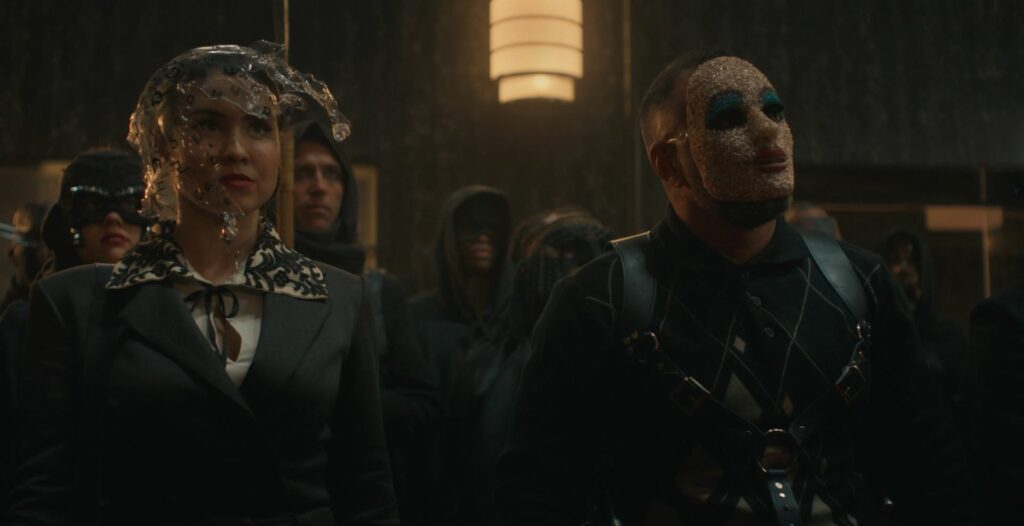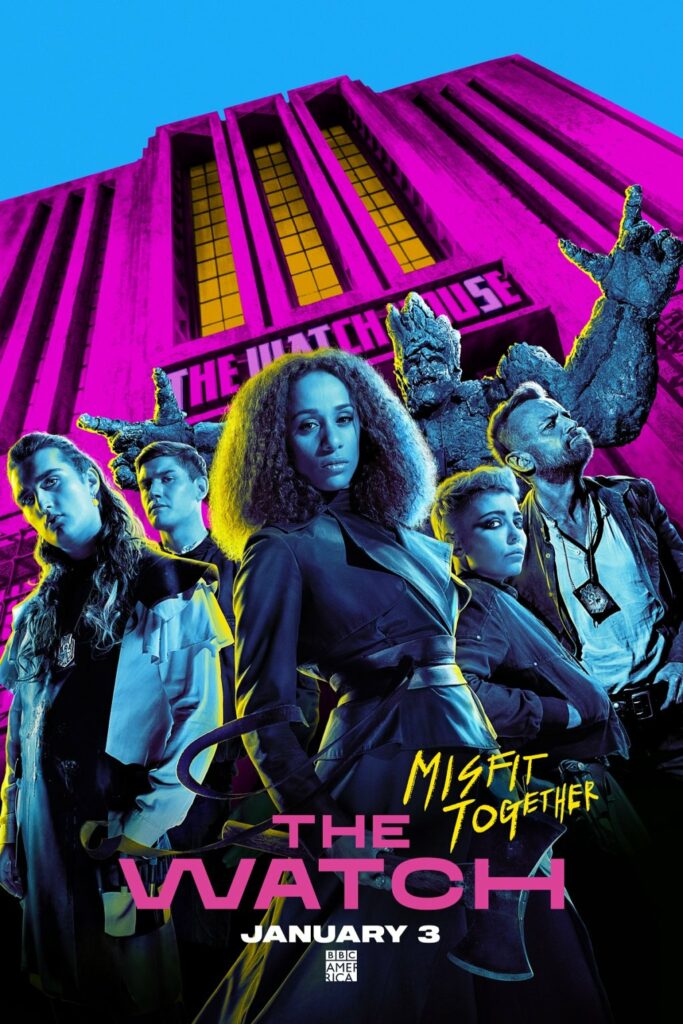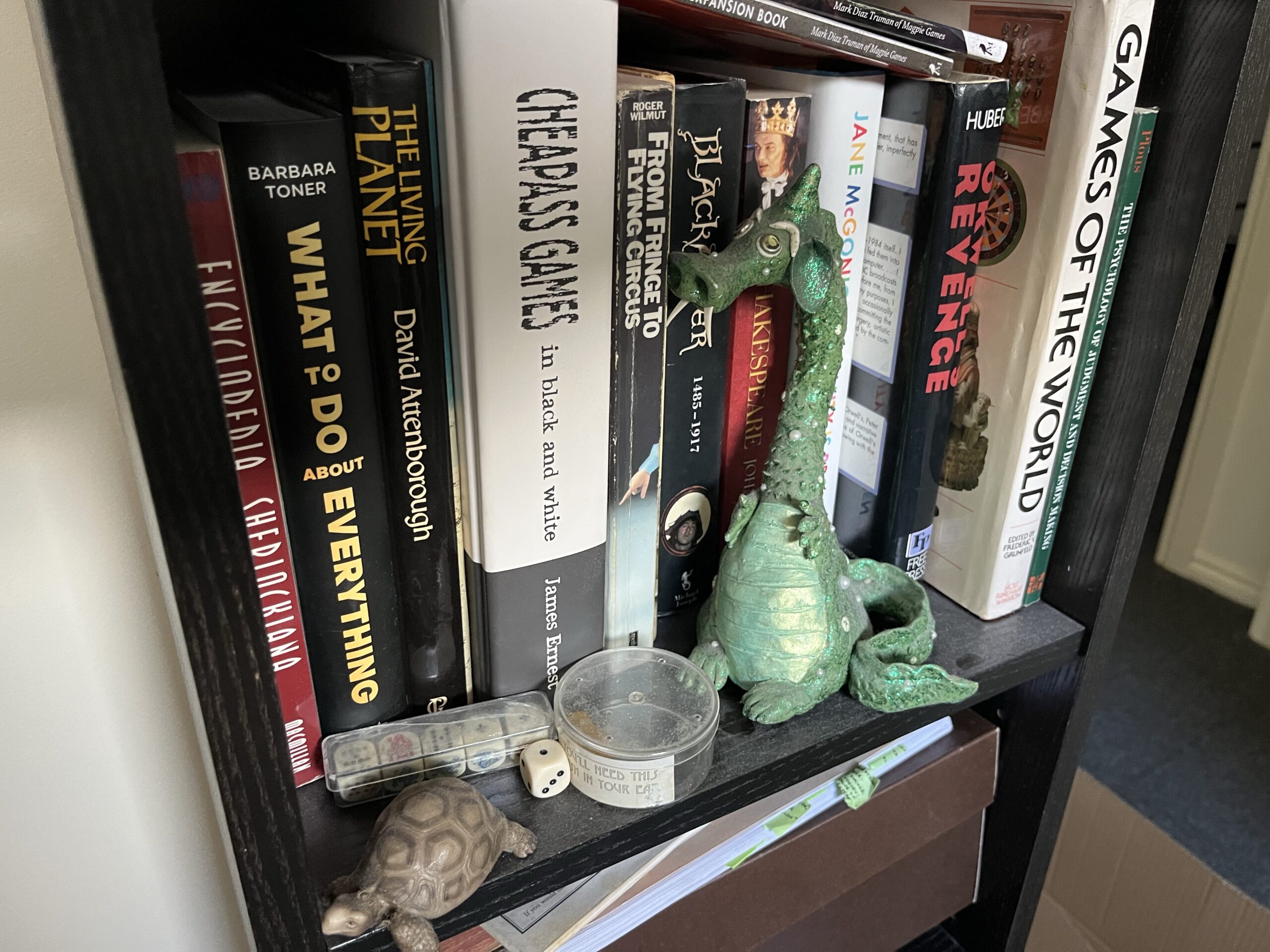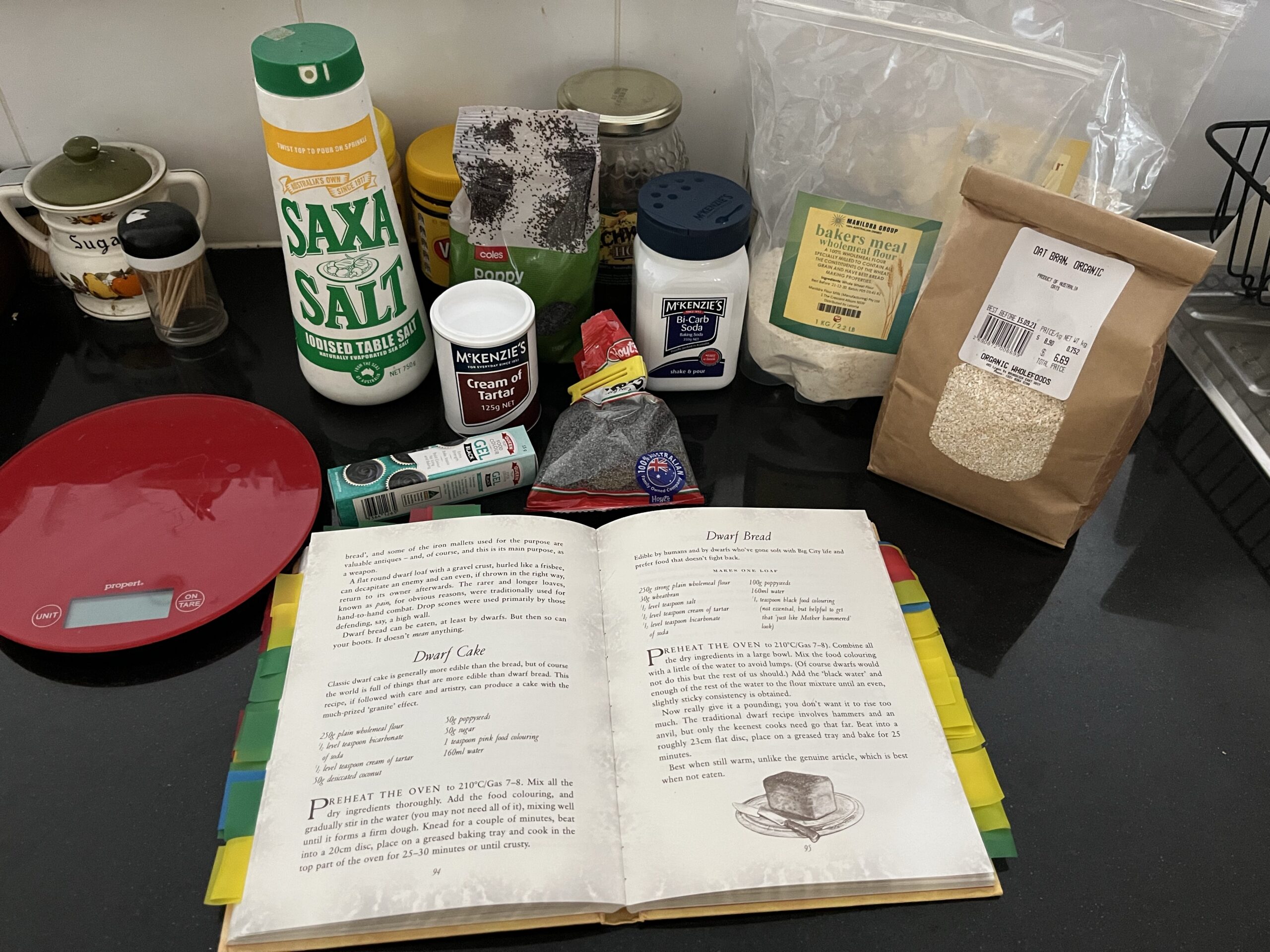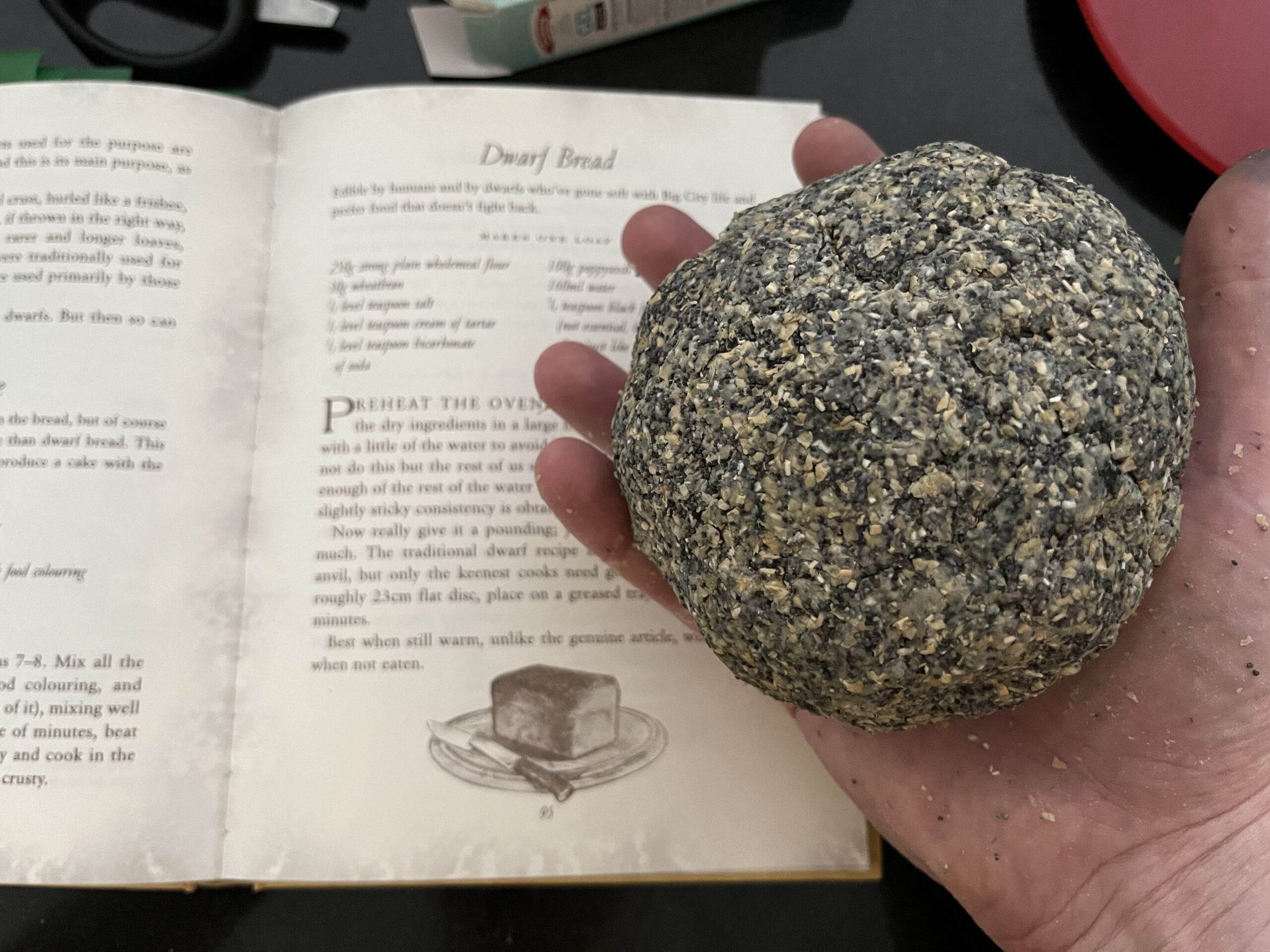#Pratchat55 Notes and Errata
These are the episode notes and errata for Pratchat episode 55, “Mr Doodle, the Man on the Moon“, discussing the twenty-seventh Discworld novel, 2001’s illustrated “Discworld Fable”, The Last Hero with returning guest Georgina Chadderton (aka George Rex).
Iconographic Evidence
Here are George’s drawings that we mentioned in the podcast!
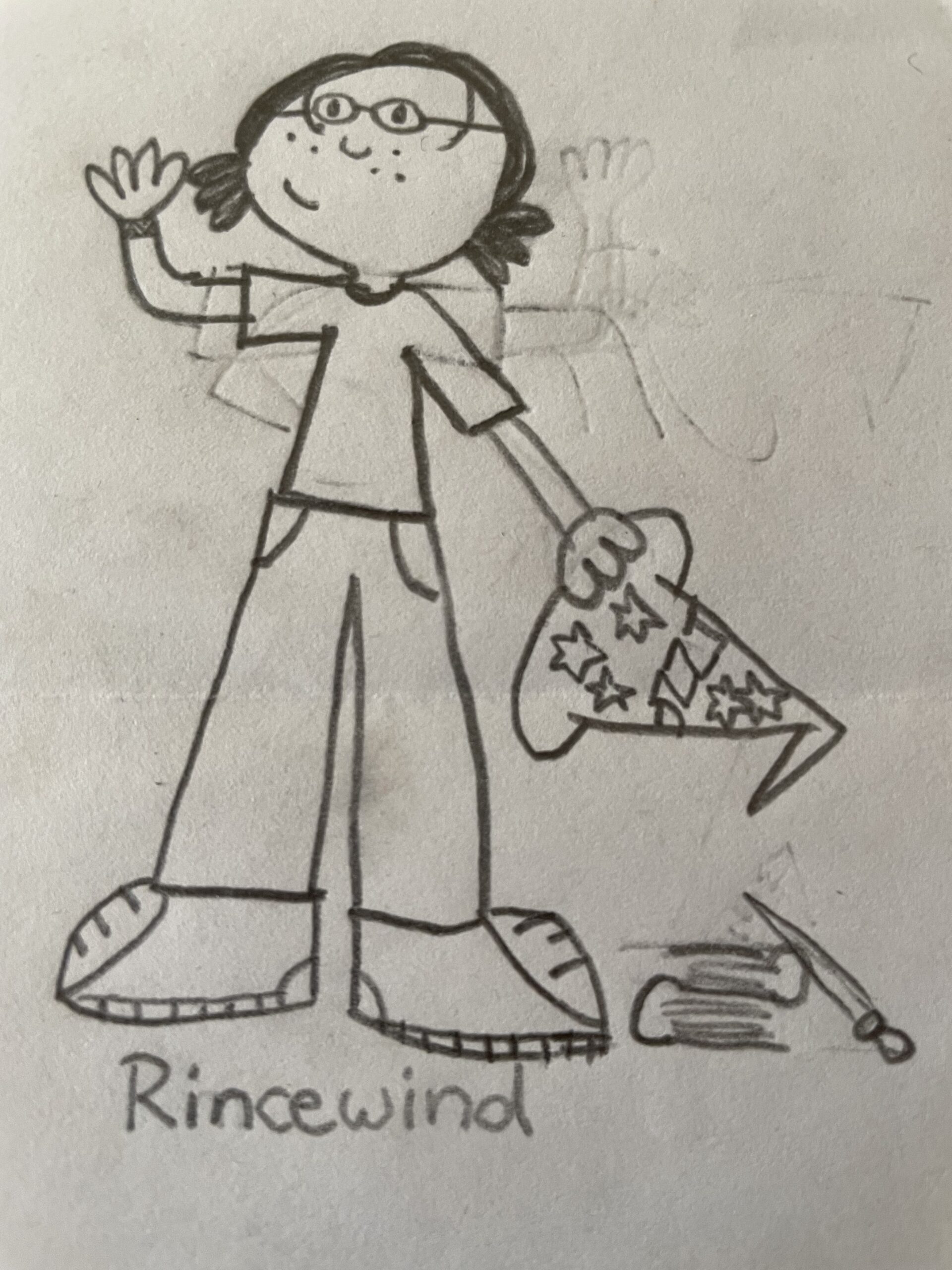
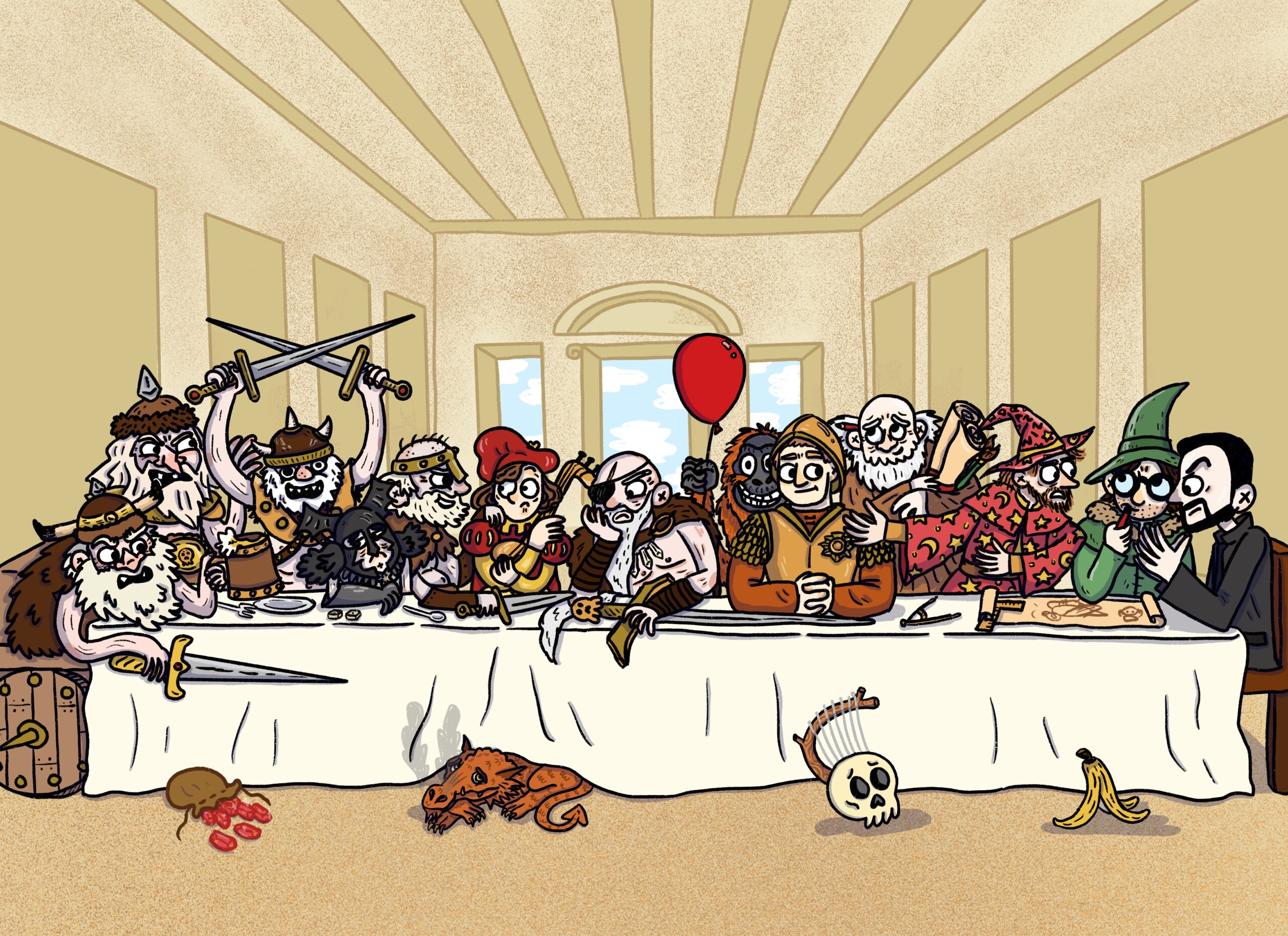
Notes and Errata
As a quick note, we’ve preferenced using page numbers from the 2002 and 2007 editions of the book, since they’re probably the one you have. We’ve included page numbers for the first edition (where relevant) in brackets.
- The episode title is a reference to Australian children’s television icon Mr Squiggle, the “Man from the Moon” who visited Earth in his pet rocket (named Rocket) to turn children’s “squiggles” – scribbled drawings of random lines and shapes – into delightful pictures of birds, fish and koalas with yo-yos using the pencil he had for a nose. His show is an Australian institution, running for forty years between 1959 and 1999 on the public broadcaster, the ABC. We previously mentioned him in #Pratchat44, “Cosmic Turtle Soup“. (The episode was originally titled “Mr Leonard, the Man on the Moon”, but then Ben rediscovered that the nickname “Mr Doodle” was suggested for Leonard in Men at Arms, and it was too perfect a fit not to change it!)
- Other guests who’ve returned after a few years include Cal Wilson (in #Pratchat1 and #Pratchat3, and then #Pratchat50), Stephanie Convery (#Pratchat2 and #Pratchat42), Richard McKenzie (#Pratchat5 and #Pratchat40), and most recently Nadia Bailey (#Pratchat17, then #Oggswatch2021 #Pratchat54). Guests who’ve come back without such a big break include Will Kostakis, Fury and Joel Martin. (If there’s a guest you’d love us to get back on the show, let us know! We already have a few in mind…)
- Adelaide is the capital of South Australia, and the smallest state capital on the mainland (Hobart in Tasmania is much smaller). Unlike the other British colonies in Australia, it was established by free settlers rather than convicts, but it still nearly destroyed the Kaurna people who lived there. Like Australia’s many smaller cities (basically everywhere that’s not Sydney or Melbourne), it has a reputation of being more like a big country town.
- Earthquakes in Australia are usually too minor to be noticed by humans, but in March 2022 Adelaide experienced two big enough to rattle windows and give people a fright (and prompt the posting of images of garden chairs knocked over with captions like “We will rebuild”, a common sentiment when mild disasters occur). Adelaide is surrounded by fault lines, though, which explains why sometimes they get a few in a row; this ABC News article gets into the details (and gives an example of the meme we mentioned).
- If you want to get a preview of George’s graphic novel, she released Oh, Brother, a teaser of the original version, which you can find in the shop on her website. (Ben’s read it, it’s really good.)
- You can find out more about the Paper Cuts Comics Festival on their website, papercutscomicfestival.com.
- Mrs. Harris Goes to Paris is a British comedy film directed by Anthony Fabian set to be released in July 2022. It’s based on the 1958 novel Mrs. ‘Arris Goes to Paris by Paul Gallico, and stars Lesley Manville as the titular cleaner living in post-war London, who dreams of escaping her life and owning a fancy gown made by Christian Dior. The nearly three-minute long trailer does indeed reveal pretty much every plot beat of the film.
- In Greek mythology, Prometheus is one of the younger Titans who helped the gods overthrow the other Titans. In many versions of his story, he subsequently tricked Zeus, including causing him to accept bones and fat rather than meat as a sacrifice from mortals, which is what angered Zeus into hiding fire from them. Prometheus then stole it back, but in some accounts also taught humans many other hallmarks of civilisation, and possibly saved them from obliteration at Zeus’ hand. For these transgressions he was, like Fingers-Mazda, chained to a rocks and had his liver eaten by an enormous eagle in the day, only to grow whole again overnight to repeat the torture for eternity. He is eventually freed by Heracles, in some versions with Zeus’ permission, though Heracles kills the eagle rather than letting Prometheus do it.
- The Bayeux Tapestry is a famous artwork depicting the history of the Norman Conquest of England in 1066. It’s huge, almost 70 metres long, and was probably made in England not long after the events describes, perhaps in the 1070s. Traditionally it is thought to have been commissioned by Queen Matilda, the wife of William the Conqueror, but historians consider it more likely to have been commissioned by the Bishop Odo, William’s half-brother. It got its name in the 18th century when it came to the notice of scholars as it was displayed in a cathedral in Bayeux, Normandy. The seventy or so illustrations on it are not woven into the linen fabric, as in many tapestries, but are embroidered, using a form of wool yarn, leading some scholars to prefer the term “Bayeux Embroidery”, though many think this is splitting hairs as the term “tapestry” isn’t that precise.
- Fan service means anything including in a work of fiction that’s specifically designed to please an existing fan base. The term originates with Japanese manga and anime, where it often more specifically means content which is titillating or sexual in nature.
- If you’re interested in learning about the visual literacy in comics, and in general about how comics work, we highly recommend the now classic work by Scott McLeod, Understanding Comics.
- A Clockwork Orange is a 1962 science fiction novel written by English author Anthony Burgess (1917-1993). It depicts a dystopian future in which teenagers speak in a slang called “Nadsat” (from the Russian suffix meaning “-teen”) and form gangs to engage in random acts of “ultra-violence”. The protagonist, Alex, recounts some of his exploits, including falling out with his gang and being abandoned by them after an assault and robbery to be arrested, imprisoned and eventually put through an experimental form of aversion therapy, the “Ludivico Technique”. Stanley Kubrick famously filmed the novel in 1971, with a young Malcolm McDowell in the role of Alex; the film was controversial for including the violence (including murder and rape) present in the book, and has been hugely influential, introducing some of the slang terms like “droogs” (friends) and “ultra-violence” into common parlance. The Kubrick film was based on the US edition of the novel, which omitted the final chapter, and Burgess did not like the result. Burgess himself wrote a musical stage adaptation in 1987, and there have been many other stage productions since.
- bell hooks (1952-2021) was the pen name of Gloria Jean Watkins, an academic, activist and writer who wrote many influential books about race, feminism and class. hooks used lowercase for her pen name (which was also the name of her Great Grandmother) in an attempt to emphasise the work over the person. Ben is mistaken when he says she doesn’t use much capitalisation or punctuation, though; while she does favour plain language and long sentences, she uses standard English grammar.
- There have been four editions of The Last Hero in English:
- The original 2001 hardcover (160 pages; UK – Victor Gollancz, ISBN 0-575-06885-X; US – HarperCollins, ISBN 0-06-104096-7) is the one all three of us have read. It has Cohen atop a mountain on the cover, and is roughly 24cm wide and 28.5cm tall. As far as we know is the only one to feature the full-colour illustration of Leonard on the Moon looking at the Disc, which appears on the back cover of the dust jacket. (A pencil drawing of this illustration appears in the background on page 121 (or page 133 in the later editions). There’s a German translation of this edition, but it seems most other translations are of the second edition.
- 2,000 copies were made of a limited “Deluxe Edition” of the UK hardcover (ISBN 0-575-07370-5), though we’re not sure what exactly was different about it – all the photos we can find look just like the hardcover Ben has with the dust jacket taken off! (For the record: the cloth cover underneath is plain black, embossed with the title, authors’ names and just Cohen from the original cover in gold.) Some sources list it as a “slipcase” edition, so it might have been exactly the same except with a slipcase instead of a dust jacket. (It was only £25 compared to the standard edition’s price of £17.99, so this minor change seems about right.)
- The 2002 paperback edition (176 pages; UK – Victor Gollancz, ISBN 0-575-07977-2; US – Eos/HarperCollins, ISBN 0-06-050777-2) has the same page dimensions as the original hardcover (though the cover is a little smaller). This one features the Rincewind “Scream” cover and includes text describing it as “The No. 1 Bestseller” and “Includes 16 pages of all-new illustrations”. That the new illustrations did not appear in the deluxe edition caused some fans to be disgruntled with the publishers…
- The 2007 paperback edition (176 pages; Victor Gollancz, ISBN 978-0-575-08196-3) is pretty much exactly the same as the 2002 version, except with an illustration of the entire Silver Horde on the cover, and it’s smaller: about 17cm wide and 19.5cm tall. Thanks to the specific layout, the page numbers are identical. This version has stayed in print since it was introduced, and is also the version on which the ebook, published in 2015, is based.
- There’s also an audiobook of The Last Hero, published in 2008 by Isis Books (ISBN 978-0-7531-4058-1 / 040202) – the company with the original license to produce unabridged audiobooks of Pratchett’s works. Its narrated by Stephen Briggs. Its unclear as yet if a new audiobook of The Last Hero will be released as part of the new Penguin Audiobooks…
- The Scream – whose actual title is Skrik (Norwegian for “Shriek”) or Der Schrei der Natur (German for “The Scream of Nature”) – is an 1893 pre-expressionist artwork by Norwegian artist Edvard Munch (1863-1944). It depicts a bald figure in the foreground, standing on a bridge or pier near the sea, under a red sky; the figure is clutching its head and has its mouth open in a scream. Munch painted four versions, two in oils and two in pastels, and a lithograph – a carved version from which several monochrome prints were made, some of which were then hand-coloured by Munch. The first version is on display in the National Museum of Norway in Oslo, and bares a pencil inscription in Norwegian, written by Munch, that went unnoticed until 1903: “Kan kun være malet af en gal Mand!“, “Could only have been painted by a madman!”
- Is Rincewind a “young person”? He’s certainly much younger than Cohen, but by the time of The Last Hero he would by some accounts be around 57, though he looks considerably younger in Kidby’s drawings. Perhaps wizards age more slowly than other folks – or his time in the Dungeon Dimensions put a temporary stop to his physical ageing.
- Ben makes good on his promise to describe at least most of the new illustrations from the second and later editions, but for reference, here’s a list:
- Pages 50-51 – a map of part of the Disc, showing the route of the fleet that set out from Ankh-Morpork towards Krull.
- Pages 70-71 – a portrait-oriented image of Death, the Death of Rats and Albert (holding a kitten in a box) looking up at A’Tuin’s immense life timer.
- Pages 90-91 – the view down to the Hub from the spire of Cori Celesti.
- Pages 104-105 – the Kite flying towards the viewer off the edge of the Rimfall.
- Pages 116-117 – a painting of the wizards, the Luggage and Vetinari in the darkened hold of the ship, looking at the glowing lines of the spell tracking the Kite‘s path. (This is the one Ben later thinks is based on an existing work; see below for the answer we’ve come up with, thanks to subscriber Fiona Margolotta!)
- Pages 126-127 – a portrait-oriented image of Rincewind on the moon, with one of the elephants in the background, in “the Scream” pose. (This is the image used for the cover of the second edition.)
- Pages 138-139 – Ridcully, Ponder and another member of the Faculty (possible the Lecturer in Recent Runes) in the bow of the ship, the Luggage in the prow. The wizards are looking up at the moon, where the Kite blasting off can be seen, resembling a shooting star. Ridcully is fishing over the side of the ship – there’s a pile of very weird fish on the deck, and a worried looking sea serpent in the ocean. (This scene doesn’t quite appear in the text, but it’s a great painting.)
- Pages 154-155 – a parody of Michelangelo’s “The Creation of Adam”, depicting Cohen in Adam’s pose giving the finger to Blind Io, who takes the place of the Christian God, and is surrounded by the other gods. (This appears in sketch form in the background of the pages where Rincewind talks the heroes out of their plan, on pages 144-145 of the first edition and 160-161 of the later editions.)
- Our episode about Interesting Times was #Pratchat21, “Memoirs of Agatea“, a pun on the novel and film Memoirs of a Geisha. (See the episode notes for more.) The pun just about still works if you pronounce it “A-gatt-ee-ah”… Sadly the official source, The Discworld Companion, neglects to supply a pronunciation, but probably whatever Stephen Briggs says in the audiobooks is “correct”.
- Old Vincent is noted as being 87 in Interesting Times, and having trouble with his memory. He is not actually the oldest of them; that would be Mad Hamish, who in Interesting Times is 105. Cohen himself estimated his own age as between ninety and ninety-five, while Caleb the Ripper was 85. Boy Willie is noted as being the only one under eighty.
- How much time has passed since Interesting Times? As usual there’s no canonical answer, but clues and fan theories suggest it’s probably been about three or four years.
- The Cabin in the Woods is a 2011 horror comedy, directed by Drew Goddard and written by Goddard with Joss Whedon, which parodies slasher films and serves up a critique of more modern “torture porn” style horror films. It has a great cast, including Chris Hemsworth (of Thor fame) and Bradley Whitford (of The West Wing), plus many actors familiar from Buffy the Vampire Slayer and/or Angel. It has a stereotypical collection of college student horror characters head for a weekend in cabin out in the woods, while a pair of scientists observe them and subject them to chemicals and other stimuli that force them to behave like horror movie characters, all leading to a mysterious ritual. The scientists receive messages from other labs around the world advising them that other experiments have failed, leaving the American team as the last hope…and we won’t spoil any more than that, because it’s a pretty great film.
- The Agatean Empire does not appear in any subsequent novels, but there is a canonical answer to what happens next in The Compleat Discworld Atlas, so we’ll revisit this when we cover that book.
- Leonard of Quirm – as he is more often called, though he is also referred to as Leonard da Quirm in the books – is first mentioned in Wyrd Sisters (see #Pratchat4), where he is responsible for designing the wave machine used for special ocean effects at The Dysk theatre in Ankh-Morpork. Notably he is still “at large” in that book, working primarily as a painter from the Street of Cunning Artificers, and doing engineering as a side hustle. He’s safely ensconced in the Patrician’s palace by the time of Men at Arms (#Pratchat1), having designed and built the gonne which – deemed more dangerous than the other things Leonard had actually constructed – was meant to be destroyed by the Assassin’s Guild. By the time of Jingo (#Pratchat27) he’s been in the palace for five years – and we realise he does get to go along on the submarine adventure in that book, but only under the Patrician’s strict supervision. He also appears in The Fifth Elephant (#Pratchat40), and is mentioned briefly in Soul Music (where one of his illustrations inspires the Librarian to build his motorcycle; see #Pratchat19) and The Truth (where Mr Tulip admires one of his artworks; see #Pratchat42), but will only return once more, in Monstrous Regiment.
- Cohen doesn’t wear a loincloth – it’s always been described and illustrated as a “leather hold-all”, like the furry underpants worn by He-Man.
- The exhibition of Terry’s life and work that Ben remembers was Terry Pratchett: HisWorld, which featured at the Salisbury Museum from September 2017 to January 2018. Two books were produced for the exhibition – one limited edition small hardcover available only at the exhibition, and another larger art book. and you can find it and details of the exhibition at pratchetthisworld.com. The Shed of Doom was not actually build for HisWorld, but the following year for the Chalke Valley History Festival, where the HisWorld recreation of Terry’s writing room was also exhibited again. We’ve included a Tweet from the official @Discworld_com account below with some great photos of the Shed, and the CVHF also have a time-lapse video of its construction on Vimeo.
- In the Pokémon series of videogames, there are several goals: one is to fill out your “Pokédex”, an index of every Pokémon creature, by capturing at least one specimen of every species. But you are also on a quest to prove yourself as the greatest Pokémon trainer in the region, usually by defeating the gym leaders – the best trainer is each of the local “Pokémon gyms”, which are basically training camps for Pokémon trainers, usually specialising in Pokémon of a certain type. When you enter a gym you find a unique (or at least distinctive) challenge you must overcome to get to the gym leader, which always includes fighting Pokémon battles against their gym members. And that’s even before you get to the final part of each game, which involves battling against the champion trainers above the individual gyms! Which is all to say that Evil Harry Dread being one of those unnamed trainers in the gym before the leader is a pretty scathing review from Liz of his Evil Overlord status.
- Crufts is a famous UK dog show. We previously talked about it briefly in #Pratchat7A, “The Curious Incident of the Dragon and the Night Watch“.
- The Nothingfjord Blue swamp dragon does indeed seem to be a clear reference to Monty Python’s famous “Dead Parrot Sketch”. In the sketch, Mr Praline (John Cleese with a silly voice) tries to return a large, blue and clearly dead parrot to a pet shop, the owner of which (played by Michael Palin) tries to argue that it is not dead. The parrot in the sketch is described as a “Norwegian Blue” (a nonexistent species) which has “beautiful plumage”; the shopkeeper at one point claims that it is “pining for the fjords”. NoThingfjord, meanwhile, was first mentioned in The Last Continent as the birthplace of Mad the dwarf. It’s also mentioned in The Last Hero – it was the Duke of NoThingfjord who employed Mad Hamish and other members of the Silver Horde as mercenaries, in the battle they were asked to repeatedly re-stage for the purposes of capturing it in a tapestry. Some more details are given in The Discworld Mapp, where it’s revealed that it’s home to the Discworld’s equivalent of vikings, who were great explorers but not very successful raiders since they always made appointments with their potential victims, giving advance warning of their arrival.
- The barbarian heroine in The Light Fantastic is Herrena the Henna-Haired Harridan, who also gets a passing mention in Eric. We should also give Conina, Cohen’s daughter from Sourcery, a shout-out too.
- Open All Hours was one of two successful BBC sitcoms developed from Seven of One, a showcase of sitcom pilots starring Ronnie Barker, which was broadcast in 1973. (The other was the prison comedy Porridge.) Barker, in a false moustache and pronounced stutter, plays Arkwright, the owner of a corner store in Yorkshire, who longs for and lusts after Nurse Gladys, who lives across the road with her elderly mother. He also attempts to teach all his dirty tricks for selling to customers to his assistant, his orphaned nephew Granville, played by David Jason – known to Discworld fans as both Albert in the live-action adaptation of Hogfather, and Rincewind in the live-action adaptation of The Colour of Magic and The Light Fantastic. Open All Hours ran for four series between 1976 and 1985, and remained popular enough to spawn a sequel, Still Open All Hours, in which Granville (still played by David Jason) has taken over the store. Still Open All Hours has had six series between 2014 and 2019.
- Liz has mentioned Diana Wynne Jones’ fantasy novel The Homeward Bounders before, in #Pratchat31, “It’s Just a Step to the Left”, and #EeekClub2021, our first special episode discussing topics chosen by subscribers. In the book, demonic entities known only as Them play a boardgame with the denizens of the many alternate universes that exist – in part by selecting mortals who will be thrown out of their own universe, and must then try to make it home.
- The Mysterious Cities of Gold (in Japanese 太陽の子エステバン, “Esteban, Child of the Sun“, and in French Les Mystérieuses Cités d’Or) is a French-Japanese animated television series that ran for one season of 39 episodes in 1982 and 1983. Set in the sixteenth century, the show follows three children – Esteban, Mia and Tao – as they travel with (and sometimes run from) the roguish explorer Mendoza and his bumbling sidekicks, as they search for the legendary “Seven Cities of Gold”. Along the way it turns out all three of the children are connected to various ancient, technologically advanced civilisations, and they discover several technological marvels of the ancient world, including the “Golden Condor”, a bird-like flying machine roughly the size of the Kite, which is powered by the Sun. Aside from its super catchy theme song, one of the things that distinguished it from other cartoons was the live-action educational segment at the end of each episode, which aimed to teach viewers about the real-world history and cultures of South America (though let’s remember this was the early 1980s, so it probably wasn’t very culturally aware). It was broadcast in Australia on the ABC in the mid-80s, and again more recently on NITV. Three new seasons, continuing on from the original, were produced in France between 2012 and 2021. The new seasons also spawned two videogames.
- In the 1970s and 80s there were several European-Japanese co-productions in animation, predominantly in France. The other well-known example is Ulysses 31 (also created by Jean Chapolin, of The Mysterious Cities of Gold and Inspector Gadget fame), which translated the story of Odysseus/Ulysses into a science-fiction context. There are others, but they’re not nearly as well known in English-speaking countries.
- We haven’t been able to find any pictures of the Kite model made as a drawing reference, though we know that it exists from a quote from Pratchett himself, featured in the Annotated Pratchett Guide. We’d still love to see it, though, so if anyone knows of any photos that exist, please send us a link!
- NASA did send an ape into space! There were many monkeys and apes involved in the early spaceflight program at NASA, used as passengers or even trained pilots in test flights made prior to sending a human. This was not, of course, very nice for the animals, many of whom did not survive; in fact before they returned from any mission, the chimpanzees at NASA were only given numbers, not names, to reduce the emotional impact of press stories about their deaths, which puts the whole thing into grim perspective. But the success story of the program was Ham, the chimp who became the first great ape in space when he successfully returned from a sub-orbital flight on January 31, 1961. He lived for another twenty-two years, mostly at a Zoo in Washington, D.C., and when he died he was buried at the International Space Hall of Fame – a much nicer end that the original plan to stuff him and put him on display in the museum, something Russia did with some of the dogs from its own early space program.
- Goodby Bindle Featherstone of Quirm – better known as Errol – appears in Guards! Guards!, where he is first encountered by Vimes on his visit to Lady Ramkin to learn about dragons. He is later gifted to Vimes, who has already taken a liking to him, and gains his shorter name when Nobby comments that “he looks more like my brother Errol”. His ability to flame from the, er, other end is said in that book to be partly genetic and partly down to the swamp dragons’ ability to rearrange their internal plumbing to make use of whatever fuel they can find.
- Leonard’s drawings of swamp and moon dragons appear on pages 77 and 129 (73 and 117 in the first edition).
- The painting of Ridcully fishing near the Circumference while the Kite blasts off from the moon is on pages 138 and 139.
- The painting of the wizards observing the spell (from pages 116-117 of the later editions) appears to be based very specifically on A Philosopher giving that Lecture on the Orrery in which a lamp is put in place of the Sun, painted in 1766 by Joseph Wright of Derby. Wright’s style (and Kirby’s excellent copy of it) probably seems familiar to you – he also painted An Experiment on a Bird in the Air Pump, which was the inspiration for Kidby’s cover painting for The Science of Discworld. (See #Pratchat35, “Great Balls of Physics“, for more information.) Thanks to subscriber Fiona Margolotta for helping us solve this mystery!
- The picture of Cohen holding his sword outside the background that frames him appears on page 136 (124 in the first edition). There doesn’t appear to be a general term for this in art, but in comics it’s known as a breakout panel, or panel breaking.
- The Lady first appears in The Colour of Magic, where she appears to Rincewind and Twoflower, giving them a chance to escape their fate (and, er, Fate) in Krull. She also appears in Interesting Times, starting a new game against Fate. Her original description states that her eyes are “Not the pale green of ordinary eyes … the green of fresh emeralds and as iridescent as a dragonfly.” Interestingly they’re not described as being entirely green until Interesting Times, though the dryad Rincewind meets earlier in The Colour of Magic does have eyes like that.
- Modern dice have their numbers arranged so that the ones on opposite faces add up to the number of faces plus one. This arrangement – called “sevens” for the sum on a six-sided dice – makes sure that if the dice gets flattened somehow, making the numbers on two opposite sides more likely to be rolled, the average result of the dice will stay the same. Ben has a novelty twenty-sided dice a bit bigger than a golf ball that’s like this; it mostly rolls a 3 or an 18, but this still evens out to good or bad luck. The sevens configuration goes back to ancient Roman times, though it fell out of fashion around the twelfth century, when dice became more standardised and switched to a “primes” configuration. Sevens came back into vogue from around 1450 – seemingly alongside an increasing understanding of mathematics and basic probability during the Renaissance – and was extended to other die sizes too. (As an aside, we’re using “dice” as both singular and plural here, which is accepted modern usage.)
- The Scandanavian story of the dice is the story of Oláf Haraldsson from the Heimskringla saga, told by Snorri Sturluson – though even he thought it was a bit on the nose, and credited the story to another bard, Thorstein the Learned. Haraldsson was a Norwegian Viking who in 1015 proclaimed himself King Oláf II of Norway in a bid to reclaim his land from Danish and Swedish rule. He sorted out the Danes without much trouble – King Canute was not much interested in Norway at the time – and made peace with Sweden, in part by marrying King Oláf of Sweden’s daughter. (This is why history is never the great for stories – who gives their two protagonists the same name?) When the two kings met to finalise which kingdom would own what, they disagreed about the Island of Hísing, but rather than go back to war they played dice for it. In a story reminiscent of one of Arnold Rimmer’s Risk stories from Red Dwarf, the Swedish king threw double-sixes; then the Norwegian King threw double-sixes; then the Swedish King threw double-sixes…and then King Oláf II therew the dice, and one split in half, showing a six and a one, giving him a result of thirteen and breaking the ongoing tie. As Ben mentions, this story is mentioned in The Science of Discworld in Chapter 34, “Nine Times Out of Ten”, about probability. (It’s Chapter 32 in the original edition.) While the result is far-fetched, it’s far from the only time powerful people have gambled for something so valuable: Ben is reminded of the story of a Japanese businessman in “Anything For the Client“, a 2015 story from the Snap Judgment podcast.
- “Are We the Baddies” refers to a series of sketches from That Mitchell and Webb Look, a BBC Three sketch comedy series starring David Mitchell and Robert Webb. In the sketches, the pair play nazi officers during World War II; Mitchell’s character begins to worry that the skulls on their caps and various other clues might mean they are not the good guys. You can watch a compilation of the sketches on YouTube.
- The illustrations of Carrot facing up to the Horde appear on pages 158 and 159 (142 and 143 in the first edition).
- Michael Williams was our guest in #Pratchat26, “The Long Dark Mr Teatime of the Soul“. His story of the time he interviewed Pratchett live on stage was cut for time from #Pratchat26, but appears in the third episode of our subscriber-only podcast, Ook Club. (Our Support Us page has info on how you can get access to that podcast.)
- We discussed Johnny and the Dead back in #Pratchat34, “Only You Can Save Deadkind“.
- Emperor Carelinus is the Discworld equivalent of Roundworld’s Alexander the Great, at least seen through the lens of mythologising and popular culture. His name might be a reference to the Roman emperor Charlemagne, also known as Carolus. Alexander famously cut the Gordian knot, whose Discworld equivalent the minstrel informs us was located in Tsort. The bit about him reaching the end of the world and weeping is based on Alexander’s life, but also seems to be specifically a reference to the movie Die Hard, where Alan Rickman’s Hans Gruber supposedly quotes the ancient historian Plutarch’s book about his life: “And Alexander wept, seeing as he had no more worlds to conquer.” That phrase, however, doesn’t appear anywhere in Plutarch – it’s cobbled together from several passages and echoes similar things from other later sources, but was invented (or perhaps messed up artfully) for the film.
- We mention the various editions of the Discworld books this episode, which is probably something to which we should devote an entire episode one of these days. But here’s a quick guide to the major ones, or at least the ones we get in the UK and Australia:
- The original English editions, published in hardcover by Gollancz (up to Jingo; Doubleday afterwards) and paperback by Corgi, had the Josh Kirby covers up until Thief of Time. From Night Watch on, they have covers by Paul Kidby. Kidby also obviously illustrated The Last Hero, but didn’t do the original cover for The Amazing Maurice and His Educated Rodents, which was by David Wyatt. Kidby did later do a cover for The Amazing Maurice, but the newest editions have covers by Mark Beech, who’s done covers (and sometimes internal illustrations) for all of Pratchett’s books for younger readers. No editions of the earlier Discworld books have been published with covers by Kidby, even though he has done illustrations for some of them. (Though see the note on the new 2022 editions below.)
- In 2012, Corgi began reissuing slightly larger B-format editions of the Discworld novels, which replaced the earlier paperback editions. These re-use Kirby and Kidby’s artwork, but reworked the cover designs, giving them a more consistent look, usually by using a smaller piece of Kirby’s artwork for the cover.
- The hardcover/cloth ones mentioned by George are the Collector’s Library editions, which we previously discussed in #Pratchat30. These were first published between 2014 and 2016 by Gollancz, Terry’s first publisher, but because they didn’t have hardcover rights to the books after Jingo, the set remained incomplete. In 2017, Terry’s later publisher Doubleday (owned by Penguin Random House) got on board and continued the series with matching editions of the later books, though the “younger readers books” – The Amazing Maurice and His Educated Rodents and the Tiffany Aching books – weren’t published in this format until 2021. Of special note: Eric has been published in this format, as just the text, but The Last Hero has not, since the format doesn’t allow for the illustrated format.
- As part of the “50 Years of Terry” celebration (marking fifty years since his first novel, The Carpet People, was originally published in 1971), new editions of “all 40 Discworld novels” will be published with a consistent cover design, coinciding with the release of the new unabridged audiobook versions (which use square versions of the same designs). Each sub-series is published together, with the standalone books distributed among the publication dates; the first batch, of the five witches books and Small Gods, were released in 2022 on Pratchett’s birthday, April 28. It seems likely The Last Hero will not be re-issued in this edition, explaining the “all 40” comment above.
- Teflon and velcro are both often cited as having been originally created to solve problems for the space program, but in fact both were invented decades earlier. This is such a persistent “fact” that NASA still has an FAQ page answering the question “Are Tang, Teflon and Velcro NASA spin-offs?“
- This is Spinal Tap is a 1984 improvised mockumenary film, directed by Rob Reiner and starring Christopher Guest, Michael McKean and Harry Shearer as the members of Spinäl Tap, a British rock band who are supposedly one of the biggest in the world. Parts of the film flash back to the band’s earlier days, including a sequence in black and white showing one of the earlier incarnations of the band, the Thamesmen, who had a Beatles-like hit titled “Gimme Some Money”. The song Ben references here, “Listen to the Flower People”, was recorded after the band changed their name to Spinäl Tap. The film is consistently named one of the funniest ever made, and established the largely improvised documentary format which Christopher Guest has returned to many times for films like Waiting for Guffman and A Mighty Wind. Rob Reiner announced in 2022 that he is planning a sequel, reuniting the original cast.
- The illustration of the Kite crew on the moon looking at the elephant and disc appears on pages 130-131 (118-119 in the first edition).
- In James Cameron’s 1986 film Aliens, Ellen Ripley (Sigourney Weaver) joins a group of marines to investigate the silence of a colony established on the planet where her crew picked up a vicious alien lifeform in 1979’s Alien. When they confirm that the aliens are still there and have killed most of the colonists, and most of the marines have been killed as well, Ripley says one of many famous lines from the film: “I say we take off and nuke the entire site from orbit. It’s the only way to be sure.” The dog-Latin version appears in Leonard’s drawings on page
- Discworld books with few footnotes from around the time of The Last Hero include Night Watch, Monstrous Regiment (each of which has only ten), The Amazing Maurice and His Educated Rodents (with just four) and Going Postal (which has none!). Thud! has closer to an average number, with twenty footnotes.
- “Second star to the right, and straight on ’til morning” are the directions given to Neverland by Peter Pan when Wendy asks his address in Peter Pan – or at least in the film adaptations. In the 1904 play Peter Pan and 1911 novel Peter and Wendy by J. M. Barrie, Peter doesn’t specify he means a star; he only says “Second to the right and then straight on till morning”, leaving Wendy none the wiser.
- At the end of the 1991 film Star Trek VI: The Undiscovered Country, the starship Enterprise is sent back to Earth to be decommissioned. Captain Kirk decides to take it on one last journey, and when asked for a heading by helm officer Chekhov, says “Second star to the right and straight on till morning.” It’s nearly the last line of he film.
- Ben mentions several sources for annotations for the book:
- The original Annotated Pratchett File entry for The Last Hero;
- The annotations page for The Last Hero on the L-Space wiki (Ben has added a few to this list);
- The Discworld wiki page for The Last Hero (look under “Popular references”; note that a fair bit of this is cribbed from other sources, it’s not very well organised, and there’s some stuff Ben considers pretty dubious, but there are still some good ones in there);
- The TV Tropes article about The Last Hero (these are organised by trope; look especially under “Call-back” for references to past Discworld books, and “Shout Out” for references to other stuff).
- You can find lots of Paul Kidby’s other artwork – including pictures of gnomes, dragons, unicorns, fairies and many more – on his website, paulkidby.com.
- The painting of Dunmanifestin is on page 17.
- The Moai – the famous statues of Easter Island – are more than 900 monolithic statues of ancestors, created by the Rapa Nui people between around 1250 and 1500. While they are often referred to as “heads”, they are complete bodies, though many of the famous photos are of Moai from the coast, which are often buried in the earth up to the shoulders. They are on average around four metres tall, but the biggest is nearly 10 metres high – and an unfinished one was more than twice that!
- Chichen Itza is a Mayan city in the Mexican state of Yucatán. Probably the biggest city of the Mayan civilisation, it is now an archeological site and tourist destination, at the centre of which is the Temple of Kukulcán, a step-pyramid also known as El Castillo or La Pirámide, names given by European explorers. It was built in worship of Kukulcán, the Mayan incarnation of the a feathered serpent deity known to the Aztecs as Qetzacoatl. A very similar temple to a fairly similar god features in Eric.
- We couldn’t identify the building out the back of Dunmanifestin on our own – but we reached out to Paul Kidby on Twitter, who told us it’s the home of the Great God Om (of Small Gods fame), as requested by Terry himself! You can see our question and his response below.
- The Man in the Moone is a 1638 novel by Bishop Francis Godwin of Hereford, in which a Spaniard travels to the moon in a chariot which is, well done Ben, drawn by swans. (The illustration of Leonard in a chariot drawn by swamp dragons – what the Patrician imagines his plan to be – appears on pages 32-33.) Godwin’s book is one of the earliest published stories about space travel, and was famous enough to be parodied by the real life Cyrano de Bergerac twenty years later, as referenced in Rostand’s famous 1897 play about Bergerac. Godwin’s story, or Bergerac’s parody, may have influenced many other writers, including Rudolf Raspe in his tales of Baron Munchausen.
- “Tribute” is the first single from American rock duo Tenacious D, comprised of Jack Black and Kyle Gass. It was originally written for their HBO television series, and was released on their first album, Tenacisou D, in 2002. In the song, the pair tell the story of how they meet a demon and beat him in a “rock off” by playing “the Greatest Song in the World”, in a manner similar to the fiddling competition from “The Devil Went Down to Georgia”. Afterwards they cannot remember the song they played, and instead write this song as a “tribute” to that one. Apparently it wasn’t a huge hit in the US, but in Australia and New Zealand we loved it, rocketing it into the top ten; its certified platinum in AUstralia, New Zealand and the UK, and also did well in the Netherlands. A version of the “rock off” features in the Tenacious D feature film, The Pick of Destiny, where they compete against Satan after plotting to steal the titular guitar pick, which is made from a piece of his horn. (Ben, a big Tenacious D fan, recommends the soundtrack album for the film, but not the film itself.)
- Ballads and sagas are different things, but only the former is usually a “story song“.
- Traditional ballads can be songs or poems, but they usually tell a story in many short verses. (Ben wrote one himself, retelling the story of Frankenstein from the perspective of the often forgotten ship’s captain whose letters serve as a framing narrative.) They were particularly popular in Ireland and England for many centuries; the name seems to derive from the medieval Scottish ballares, which itself comes from the Latin ballare, meaning “to dance”, showing that they were also originally songs you danced to. (Both ballet and the different form of French poetry, the ballade – as practised by Cyrano de Bergerac in the famous poetic fight scene near the start of Rostand’s play – also get their name from the same Latin root.) Early ballads often have anonymous sources, but they are sources of stories about Robin Hood, Beowulf and many other figures. The ballad went on to have a rich history, in storytelling, political satire and popular music, until they fell out of fashion in the 19th century.
- In historical terms, saga properly describes long prose stories from Iceland and other Scandinavian countries. The word saga (whose plural is sǫgur) is Old Norse, and evolved from meaning “what is said” to describing a story or history. (The modern words for all these things in Scandinavian languages are derived from saga.) The earliest sagas were mostly passed on orally, and were written down in the 13th century, but especially in Iceland – where the language has changed very little over a thousand or more years – they are still well understood. Probably the most famous author of sagas was Snorri Sturluson, a law speaker of the Althing in Iceland who lived in the twelfth and thirteenth centuries, and is credited with composing or compiling many sagas about Icelandic history and legend, including the Prose Edda – on which our modern understanding of Norse mythology is based – and the Heimskringla, a history of Scandanavian kings we’ve already mentioned in these notes. In modern English usage, a “saga” is any long story, especially if its told in parts; for example the main films of the Star Wars universe are usually referred to as “the Skywalker saga”.
- “Bardcore” is, as Ben says, a musical genre in which modern songs are performed in a “medieval” style, to varying levels of authenticity. There are indeed several bardcore versions of Led Zeppelin’s classic track “Immigrant Song”, from heir 1970 album Led Zeppelin III on YouTube. Our picks include this instrumental one by Constantine Bard; this one with English vocals by Grace Sledd; and this one translated into Old Norse by the Miracle Aligner, which he suggests might be better termed “Skaldcore”. Thanks to subscriber Sven who suggested that last one! (And while we’re talking “Immigrant Song”, some of Ben’s other favourite covers of it include The Cybertronic Spree, Robyn Adele Anderson (in a 1940s swing style), Karen O with Trent Reznor and Atticus Ross (for the soundtrack to The Girl with the Dragon Tattoo), and The Foo Fighters, featuring Tenacious D and Slash!)
- Sea shanties have enjoyed a few rounds of popularity on TikTok, where shared videos can be offered as a “duet”, allowing other users to record themselves singing along and post a new video of both singers side by side. (You can do this multiple times, adding many levels of voices or instruments, and its not limited to music – some very funny videos have been created this way!) Shanies are perfect for this since hey’re designed to be easy to sing, but also they are traditionally sung a cappella without harmonies, leaving lots of room for modern additions. The most well-known shanty to become TikTok famous is “The Wellerman”, particularly a performance by Nathan Evans. This YouTube compilation gives you a good idea of the form. (Evans recently did a filk song version about the 2022 Doctor Who special “Legend of the Sea Devils”.)
- The black-figure style – as seen in the image of Blind Io and Fingers-Mazda on page 8 – was very popular in Greece and parts of what is now Italy from around the 7th to 5th centuries BCE, though it hung around for a few centuries after its height. This style of art was painted in black, white and usually shades of orange or red on vases, amphorae and other ceramic vessels.
- Kidby’s parodies of Leonardo da Vinci’s work in The Last Hero include:
- A version of his most famous painting, the Mona Lisa, on page 30. This is known as the Mona Ogg, because as revealed in The Art of Discworld – another book it seems we need to cover! – she and Leonard were romantically involved in their youth. Leonard’s version is indeed a painting of a young Gytha Ogg. In fact the one in this book seems to be a new version, since the Mona Ogg has existed before the gonne affair in Men at Arms, so perhaps the original was painted in their youth?
- A version of the Vitruvian Man on pages 86 and 87, showing Rincewind strapped into Leonard’s spaceflight training device, with the usual number of arms. (This appears on pages 82 and 83 in the first edition, and it also the end papers.) da Vinci’s original artwork was an ink drawing from around 1490 titled Le proporzioni del corpo umano secondo Vitruvio, or “The proportions of the human body according to Vitruvius”. It shows a man with his arms and legs draw in two different positions, describing both a circle and a square; Rincewind is drawn only in the circular position. Vitruvius was a Roman architect, and Leonardo’s notes that accompany the drawing – in mirror-writing, of course – refer to notes Vitruvius made about the proportions of the human body in his book De architectura (“On architecture”), written around 15-30 years BCE. It’s important to note that these proportions are of a typically masculine body, and so are not truly universal.
- The story of the space pen vs the pencil is indeed mostly a myth. As Liz mentions, NASA had legitimate reasons for wanting to avoid pencils – highly flammable pencil shavings could present a hazard aboard a spacecraft, especially as graphite can conduct electricity and potentially cause a short-circuit if bits got into electronic components. The Fisher Space Pen ended up being the answer, but NASA didn’t spend billions of dollars creating it – the Fisher Pen Company was already working on a pressurised ink cartridge that enabled writing at various angles, and they perfected it after NASA reached out to them.
- A mission patch – also known as a “space patch”, since they are mostly known from space exploration – is an emblem representing a particular mission which is worn as an embroidered cloth badge by astronauts and other mission personally. They date back to one of the early soviet space missions, Vostok 6, when the first one was worn by cosmonaut Valentina Tereshkova. Mission patches come from the military tradition of shoulder sleeve insignia (SSI) or shoulder patches – embroidered badges worn on the sleeves of military uniforms, especially in the US, to show the division to which a soldier belongs. (You can see them in Stargate SG-1, where the airforce personnel assigned to the Stargate program wear patches which seem part SSI, part NASA mission patch…and they’re attached by velcro, so they can remove them when operating on Earth and avoiding disclosing the classified Stargate program.)
- The Lego Space theme is a classic theme for Lego sets introduced in 1978 and originally running until 1987. It’s logo, of a white space shuttle with a smaller red shuttle shown orbiting around it, deliberately resembles the NASA “meatball” logo. Sets using this theme were hugely popular, and it was revisited many times up until 2013. The character of Benny in The Lego Movie is a classic Lego Spaceman, with the Lego Space logo on his chest and the iconic oxygen tanks and helmet from that theme.
- Rincewind’s motto “Morituri Nolumus Mori“ echoes the famous Latin phrase “Avē Imperātor, moritūrī tē salūtant” – “Hail, Emperor; those who are about to die salute you”. While it is popularly believed to have been said by gladiators to watching emperors, there’s actually no evidence this ever happened. It is documented in contemporary histories only once, in the work De vita Caesarum (“The Life of the Caesars”) by Suetonius. There it is said by soldiers participating in a mock naval battle in 52 AD.
- In Michelangelo’s Creazione di Adamo (“The Creation of Adam”), his famous fresco in the Sistine Chapel, God is surrounded by a billowing cloak. This was famously described as a brain in an episode of the television series Westworld, but that theory is older than that – and contentious, as some think it’s more like a uterus! This article at The Verge goes into detail.
- Several books contain references to Rincewind’s childhood:
- In The Light Fantastic, upon meeting Cohen, he recalls his grandad telling him stories about the barbarian.
- Rincewind claims in Sourcery that his mother “ran away before I was born”.
- Interesting Times reveals that Rincewind “had no personal experience of either parent but felt that they were probably at least vaguely humanoid, if only briefly.”
- In The Last Continent Rincewind recognises sheep, despite growing up in the city, in part because he’d had a stuffed toy lamb as a child.
- The tradition of orphans in Ankh-Morpork being given to a Guild is mentioned not only in Thief of Time (see #Pratchat48, “Lu-Tze in the Sky with Lobsang“), where Lobsang is apprenticed to the Thieve’s Guild and Jeremy to the Clockmakers’, but also The Amazing Maurice and His Educated Rodents, where we learn Keith the pipe player was left on the doorstep of the Musicians’ Guild.
- Esk’s age does not seem to be a factor in Equal Rites, where many of the prospective wizards hoping to enter the university are young enough to be accompanied by their parents.
- Jedi are trained very young: Yoda claims the 22-year-old Luke is “too old to begin the training” in The Empire Strikes Back. The Jedi Council considered that even 9-year-old Anakin Skywalker might be too old in The Phantom Menace, and in Attack of the Clones we see a group of four- to eight-year-olds learning to use lightsabers. (Ben notes that if he tried such a thing he would certainly lose his Working With Children Check.)
- We previously mentioned Wallace and Gromit in our discussion of Thief of Time (#Pratchat48). In their first stop-motion animated short film, A Grand Day Out (1989), inventor Wallace and his long-suffering but faithful dog Gromit build a rocket and fly to the moon in search of cheese.
- Jules Verne’s De la Terre à la Lune, trajet direct en 97 heures 20 minutes (From the Earth to the Moon, a direct route in 97 hours and 20 minutes) – better known as From the Earth to the Moon – was first published in serial and novel form in 1865. In the book, an American gun club build an enormous “space gun” and use it to fire a hollow projectile containing three men with the aims of landing them on the Moon. The novel only details the adventure up until the gun is fired; their adventures on – or rather near – the Moon are detailed in the 1870 sequel, Autour de la Lune (Around the Moon).
- We previously mentioned Anne McCaffrey’s Dragonriders of Pern books in #Pratchat7A. The dragons in question are alien lifeforms on the planet Pern, where human riders form a two-way psychic bond with their dragons at the time of hatching. There are 23 novels in the series, some written or co-written by McCaffrey’s son Tom, beginning with 1968’s Dragonflight. The third part of The Colour of Magic, “The Lure of the Wyrm”, is a parody and homage to dragon fiction, including the Pern books.
- We previously mentioned the Room 101 radio show in #Pratchat39, “All the Fun of the…Fish?” It has also been a television show.
- The Repair Shop is a BBC television series in which family heirlooms are repaired and restored by experts. It first began in 2017, and is currently in the midst of its ninth season. It’s filmed at the Weald and Downland Living Museum in Singleton, West Sussex, which has a working smithy required to repair some of the items brought. An Australian version, The Repair Shop Australia, began on the Foxtel pay-TV channel LifeStyle on 3 May, 2022 – just before this episode came out!
- Chris Hemsworth plays the hot-but-stupid receptionist Kevin in the 2016 Ghostbusters film, also known as Ghostbusters: Answer the Call. We won’t say much more to avoid spoilers, but this scene of his job interview will give you a pretty good idea of what he’s about.
- Imp y Celyn – aka “Buddy” – is one of the protagonists of Soul Music, which we discussed in #Pratchat19, “It Don’t Mean a Thing If It Ain’t Got Rocks In“. In that book it’s revealed that Mort and Ysabel died when the extra time granted them by Death ran out, and their carriage ran off the edge of a mountain road. We only get a few glimpses of their life between then and the end of Mort (discussed in #Pratchat2, “Murdering a Curry“), when the couple have become the new Duke and Duchess of Sto Helit, and Ysabel is pregnant with Susan.
Thanks for reading our notes! If we missed anything, or you have questions, please let us know.

